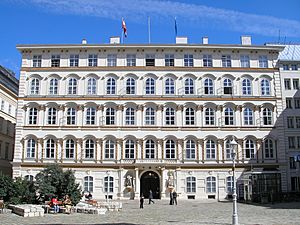Ministry of Foreign Affairs (Austria) facts for kids
| Bundesministerium für europäische und internationale Angelegenheiten | |
 |
|
| Agency overview | |
|---|---|
| Formed | 20 November 1920 |
| Preceding |
|
| Jurisdiction | Government of Austria |
| Status | Highest federal authority |
| Headquarters | Minoritenplatz, Innere Stadt, Vienna |
| Annual budget | €508 million (2019) |
| Minister responsible | |
| Agency executive |
|
The Ministry of Foreign Affairs (also known as BMEIA) is an important part of the Government of Austria. It helps Austria connect with other countries around the world. Think of it as Austria's main team for talking to other nations!
This ministry handles things like sending diplomats to other countries. It also helps Austrians who live or travel abroad. The ministry works to keep Austria's relationships with international groups strong, especially with the European Union.
What the Ministry Does
The Federal Ministry for European and International Affairs has many important jobs. It makes sure Austria has good relationships with countries all over the world. This includes dealing with international laws and agreements.
The ministry also helps Austrian citizens who are living or traveling abroad. It provides support and assistance when needed. Another key role is helping with development aid, which means giving help to other countries.
The ministry also works on matters related to the European Union. It helps Austria with economic integration and understanding European Union law. It also handles relationships with countries in Central and Eastern Europe.
Important international groups like the International Atomic Energy Agency and the United Nations High Commissioner for Refugees are also part of the ministry's work. The International Red Cross is another group it works with.
A Look Back: The Ministry's History
The city of Vienna has a long history with international diplomacy. In 1815, at the Congress of Vienna, diplomats were officially recognized for the first time. Later, important meetings in Vienna led to rules for how countries should treat diplomats. These rules are called the Vienna Convention on Diplomatic Relations (1961) and the Vienna Convention on Consular Relations (1963).
The idea of a separate Austrian diplomatic service started around 1720. This was when Emperor Charles VI gave one minister the job of handling foreign relations. For about 200 years, the ruler of Austria made all the decisions about foreign affairs.
From 1809 to 1848, Prince Klemens von Metternich was a very important Austrian Foreign Minister. Later, in 1867, the Foreign Ministry of Austria-Hungary was created. This ministry was in charge of foreign affairs for both parts of the real union (Austria and Hungary).
After World War I, the old Austro-Hungarian monarchy broke apart. For a while, foreign affairs were handled by the Federal Chancellery. It wasn't until 1959 that a separate Federal Ministry for Foreign Affairs was officially created.
In 2007, the ministry's name was changed to "Federal Ministry for European and International Affairs." This new name showed how much Austria works with other countries and international groups. In 2014, it changed again to "Federal Ministry for Europe, Integration and Foreign Affairs." Finally, in 2020, it was renamed "Federal Ministry for European and International Affairs" once more.
List of Austrian Foreign Ministers


